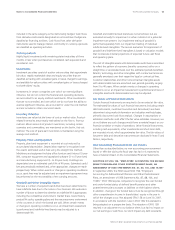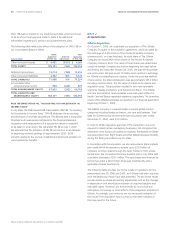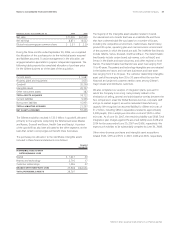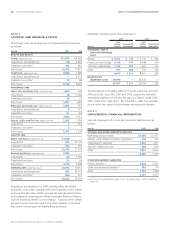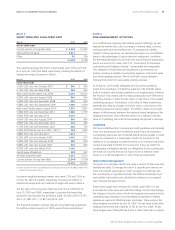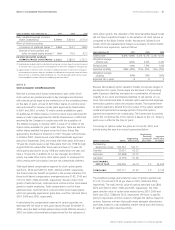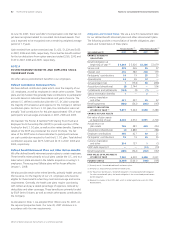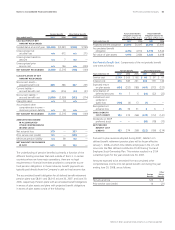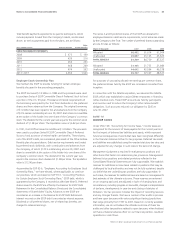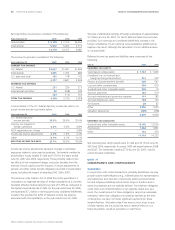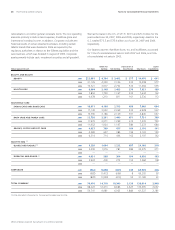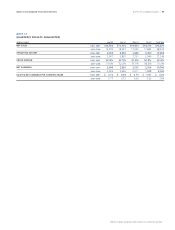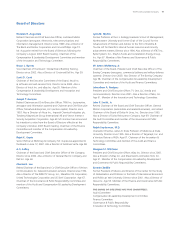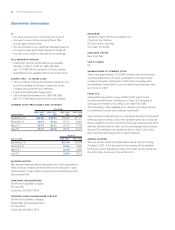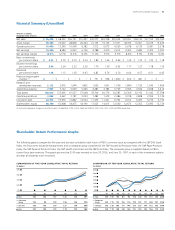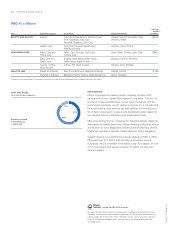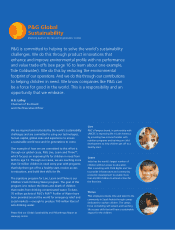Proctor and Gamble 2007 Annual Report Download - page 67
Download and view the complete annual report
Please find page 67 of the 2007 Proctor and Gamble annual report below. You can navigate through the pages in the report by either clicking on the pages listed below, or by using the keyword search tool below to find specific information within the annual report.
Millions of dollars except per share amounts or as otherwise specied.
Notes to Consolidated Financial Statements The Procter & Gamble Company 65
Total benet payments expected to be paid to participants, which
include payments funded from the Company’s assets, as discussed
above, as well as payments paid from the plans, are as follows:
Other
Years ended June 30 Pension Benets Retiree Benets
2008 $ 473 $ 199
2009 439 216
2010 454 233
2011 468 249
2012 474 263
2013 – 2017 2,654 1,523
We maintain the ESOP to provide funding for certain employee
benets discussed in the preceding paragraphs.
The ESOP borrowed $1.0 billion in 1989 and the proceeds were used
to purchase Series A ESOP Convertible Class A Preferred Stock to fund
a portion of the U.S. DC plan. Principal and interest requirements of
the borrowing were paid by the Trust from dividends on the preferred
shares and from advances from the Company. The original borrowing
of $1.0 billion has been repaid in full, and advances from the Company
of $216 remain outstanding at June 30, 2007. Each share is convertible
at the option of the holder into one share of the Company’s common
stock. The dividend for the current year was equal to the common stock
dividend of $1.28 per share. The liquidation value is $6.82 per share.
In 1991, the ESOP borrowed an additional $1.0 billion. The proceeds
were used to purchase Series B ESOP Convertible Class A Preferred
Stock to fund a portion of retiree health care benets. These shares,
net of the ESOP’s debt, are considered plan assets of the Other Retiree
Benets plan discussed above. Debt service requirements are funded
by preferred stock dividends, cash contributions and advances from
the Company, of which $123 is outstanding at June 30, 2007. Each
share is convertible at the option of the holder into one share of the
Company’s common stock. The dividend for the current year was
equal to the common stock dividend of $1.28 per share. The liquidation
value is $12.96 per share.
As permitted by SOP 93-6, “Employers Accounting for Employee Stock
Ownership Plans,” we have elected, where applicable, to continue
our practices, which are based on SOP 76-3, “Accounting Practices
for Certain Employee Stock Ownership Plans.” ESOP debt, which is
guaranteed by the Company, is recorded as debt (see Note 5). Preferred
shares issued to the ESOP are offset by the Reserve for ESOP Debt
Retirement in the Consolidated Balance Sheets and the Consolidated
Statements of Shareholders’ Equity. Advances to the ESOP are
recorded as an increase in the Reserve for ESOP Debt Retirement.
Interest incurred on the ESOP debt is recorded as interest expense.
Dividends on all preferred shares, net of related tax benets, are
charged to retained earnings.
The series A and B preferred shares of the ESOP are allocated to
employees based on debt service requirements, net of advances made
by the Company to the Trust. The number of preferred shares outstanding
at June 30 was as follows:
Shares in thousands 2006 2005
Allocated 61,614 61,904
Unallocated 23,125 25,623
84,739 87,527
Allocated 21,733 21,989
Unallocated 45,594 46,338
67,327 68,327
For purposes of calculating diluted net earnings per common share,
the preferred shares held by the ESOP are considered converted from
inception.
In connection with the Gillette acquisition, we assumed the Gillette
ESOP, which was established to assist Gillette employees in nancing
retiree medical costs. These ESOP accounts are held by participants
and must be used to reduce the Company’s other retiree benet
obligations. Such accounts reduced our obligation by $245 at
June 30, 2007.
NOTE 10
Under SFAS 109, “Accounting for Income Taxes,” income taxes are
recognized for the amount of taxes payable for the current year and
for the impact of deferred tax liabilities and assets, which represent
future tax consequences of events that have been recognized differently
in the nancial statements than for tax purposes. Deferred tax assets
and liabilities are established using the enacted statutory tax rates and
are adjusted for any changes in such rates in the period of change.
Management judgment is required in evaluating tax positions and
other items that factor into determining tax provisions. Management
believes its tax positions and related provisions reected in the
Consolidated Financial Statements are fully supportable. We establish
reserves for additional income taxes related to positions that may be
challenged by local authorities and may not be fully sustained, despite
our belief that the underlying tax positions are fully supportable. In
such cases, the reserves for additional taxes are based on management’s
best estimate of the ultimate outcome. These reserves are reviewed
on an ongoing basis and are adjusted in light of changing facts and
circumstances, including progress on tax audits, changes in interpretations
of tax laws, developments in case law and closing of statutes of
limitation. Our tax provision includes the impact of recording reserves
and any changes thereto. We have a number of tax audits in process
and have open tax years with various signicant taxing jurisdictions
that range primarily from 1997 to 2007. Based on currently available
information, we do not believe the ultimate outcome of these tax
audits and other tax positions related to open tax years, when nalized,
will have a material adverse effect on our nancial position, results of
operations or cash ows.


